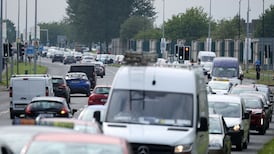THE introduction of the £220 million Luas light rail system: would cut rush hour traffic in Dublin by two per cent, according to a new report.
The report admits this drop seems insignificant, but points out that the reductions would be greater along the proposed Luas routes.
For the city centre, Inchicore and Kilmainham, it forecasts that between 6 per cent and 8 per cent of car owners will switch to Luas when it is introduced. In the case of Clondalkin, Ballymun and Tallaght, between 4 per cent and 12 per cent of journeys will be made by light rail instead of car; the equivalent figure for Dundrum and Milltown will be 4 per cent to 6 per cent.
Overall, the study says Dublin's traffic can be managed in such a way as to give maximum priority to light rail while maintaining local access and accommodating major traffic movements in the city.
Launching the report yesterday, the Minister for Transport, Energy and Communications, Mr Lowry, said it showed that the feared "gridlock" would not materialise. Detailed plans could be implemented to resolve traffic problems and ensure the city functioned smoothly, he said. Mr Lowry added that traffic along the Luas routes would be reduced by 15 per cent to 20 per cent. Asked to explain the discrepancy between this estimate and the figures quoted in the report, one engineer involved in the project said he had a "gut feeling" that traffic reductions were frequently under estimated.
The report, prepared for CIE by the consultants, Semaly/EPO, makes detailed proposals for the rerouting of traffic to make way for Luas. Intended as a discussion document, its proposals can be amended at a later stage.
The report bases its conclusions on the traffic management play proposed by Dublin Corporation, which aims to steer traffic away from the light rail corridors extending from St Stephen's Green North down Dawson Street and Grafton Street, i.e. on to South Great George's Street, St Stephen's Green East and Kildare Street.
While the corridors would experience reduced traffic and become "pedestrian friendly" streets, considerable increases in traffic are forecast in other streets. Traffic on Earlsfort Terrace and St Stephen's Green East would double; on Kildare Street St Stephen's Green South, Caper Street and South Great George's Street, the increase would be at least 25 per cent.
Among the areas where reduced traffic is forecast are the Naas Road, Inchicore village, Old Kilmainham, James's Street, Church Street, St Stephen's Green West (by 75 per cent) and Harcourt Street.
Lower Graft on Street would become a public transport corridor, as would Nassau Street between Dawson Street and Grafton Street. Dawson Street would be restricted to public transport and access traffic only in a south bound direction.
Another public transport corridor would be created on St Stephen's Green North between Grafton Street and Dawson Street, but the east and south sides of the Green would become two way. The direction of traffic flow along Kildare Street would be switched to north bound.
The consultants favour the construction of a new link road in place of the existing bus depot on Abbey Street in order to facilitate truck access to the Marks and Spencers depot.









